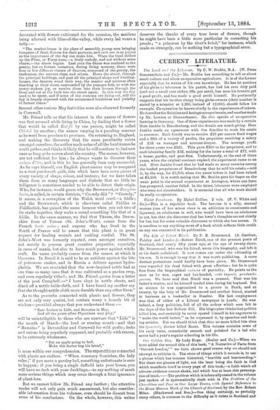CURRENT LITERATURE.
The Land and the Labourer. By C. W. Stubbs, M.A. (W. Swan Sonnenschein and Co.)—Mr. Stubbs has something to tell us about small culture and about co-operative agriculture. It is of the former especially that he writes of his own knowledge. He has let portions of his glebe to labourers in his parish, has had his rent duly paid (and not a small rent either, 66s. per acre), has seen his tenants get a good profit, and has made a good profit himself. He pertinently suggests that his brother clergy being glebe-owners (their number is stated by a misprint at 1,200, instead of 12,000), should follow his example. Co-operation he knows chiefly in the experiments of others. He describes the Ralahine and Assington experiments, and another made by Mr. Lawson at Blennerhasset. He also speaks of co-operative farming in Germany. One of these experiments was made by a certain Herr Jankhe iu Brandenburg, and the details are worth giving. Herr Jankhe made an agreement with five families to work his estate in common. Each family was to receive £25 per annum fixed wages and a fifth of a moiety of profits, the proprietor receiving a salary of £45 as manager and account-keeper. The average profit for three years was 2521. This gave 2260 to the proprietor, and to each labouring family 252, making for the latter a total of £77, with a house, garden, and peat free. Unfortunately, at the end of three years, when the original contract expired, the experiment came to an end. Herr Jankhe found that he had made so many enemies among the landed proprietors of Brandenburg that he sold his estate,—sold it, by the way, for 23,700, when five years before it had been valued at £4,500. It is worth noting that Mr. Stubbs puts his finger on the weak point in the second experiment at Assington, where one farm has prospered, another failed. In the latter, labourers were employed who were not shareholders. It is essential that all who work should be really co-operators.


































 Previous page
Previous page